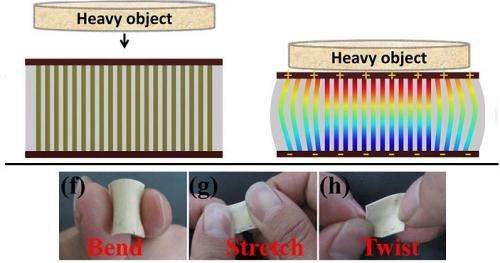January 3, 2013 feature
Nanogenerator's output triples previous record

(Phys.org)—Taking an important step forward for self-powered systems, researchers have built a nanogenerator with an ultrahigh output voltage of 209 V, which is 3.6 times higher than the previous record of 58 V. The nanogenerator, which has an area of less than 1 cm2, can instantly power a commercial LED and could have a wide variety of applications, such as providing a way to power objects in the "Internet of Things."
The researchers, led by Yong Qin at Lanzhou University in Lanzhou, China, and the Chinese Academy of Sciences in Beijing; and Zhong Lin Wang of the Chinese Academy of Sciences and the Georgia Institute of Technology in the US, have published their study on the new nanogenerator in a recent issue of Nano Letters.
The nanogenerator consists of an array of vertically aligned 420-μm-long nanowires, with electrodes on the top and bottom of the array. Under the periodic impact of an object weighing about half a pound, or simply the press of a finger, the nanogenerator experiences a pressure that causes the nanowire array to deform. Due to the piezoelectric effect, this mechanical compression drives electrons toward the bottom electrode, generating an electric current. When the heavy object is removed, the pressure is released and the electrons flow back through the circuit. By repeating this periodic mechanical deformation on the nanogenerator, the researchers could generate electricity.
The scientists found that the amount of electricity generated by the nanogenerator depends on the impact force. By dropping an object with a weight of 193 grams onto the nanogenerator from different heights ranging from 5 to 13 mm, the scientists observed that the output signal is proportional to the square root of the falling height.
In their experiments, the researchers demonstrated that a large enough impact force applied to the nanogenerator can generate a peak voltage of 209 V and a peak current of 53 μA, corresponding to a current density of 23.5 μA/cm2, which is 2.9 times higher than the previous record output current density of 8.13 μA/cm2.
"The power output of a nanogenerator depends on voltage and current, because the output power is the product of the voltage and current," Wang told Phys.org. "By raising the output voltage, we naturally raised the output power. This is essential for any and all applications for driving small electronics, portable electronics and wireless sensors."
The researchers showed that the power output achieved here is high enough to directly power a commercial 1.9 V LED. Unlike most other nanogenerators, the new device does not require an energy storage unit, an advantage that can enable self-powered systems to operate in a wide variety of environments.
Besides powering an LED, the nanogenerator may also have biological applications. Here, the researchers used the nanogenerator to stimulate a frog's sciatic nerve and cause the frog's gastrocnemius calf muscle to contract. Previously, this phenomenon has been demonstrated using a large nanogenerator with an area of about 9 cm2, whereas the new nanogenerator with an area of just 0.95 cm2 can perform the same nerve stimulation and induce muscle movement under the small impact of a tiny finger tap.
In the future, tiny high-power nanogenerators like this one could have applications in repairing biological neural networks, in national security, and in the "Internet of Things." In this last scenario, all physical objects would be tagged (such as with radio frequency identification [RFID]), and virtually represented in a future Internet, where they could be monitored in real time.
"The future plan is to continually raise the output power so that we can meet more technological needs," Wang said.
More information: Long Gu, et al. "Flexible Fiber Nanogenerator with 209 V Output Voltage Directly Powers a Light-Emitting Diode." Nano Letters. DOI: 10.1021/nl303539c
Journal information: Nano Letters
Copyright 2013 Phys.org
All rights reserved. This material may not be published, broadcast, rewritten or redistributed in whole or part without the express written permission of Phys.org.




















